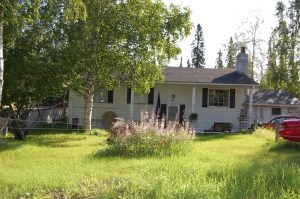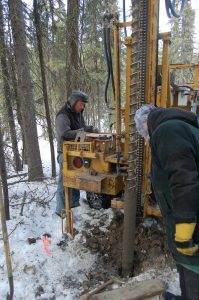What is Permafrost?
Permafrost is a type of ground located in circumpolar regions that has been frozen for at least two consecutive years. It can contain clear ice, frozen soils, rocks or other materials. The top layer of soil and/or rock, called the “active layer,” thaws during the summer and freezes again during the fall. The thickness of the active layer varies based on latitude and climate and also fluctuates annually (it can occur in non-permafrost soils as well). The permafrost layer beneath the active layer also fluctuates annually, however it remains below freezing year-round.
Permafrost Stability
The main properties that determine whether or not permafrost is stable include moisture content (ice content), soil particle distribution (gradation), and soil classification. Ground that is thaw-stable usually consists of clean granular soil or rock with little or no ice content, and does not collapse when thawed. Thaw-unstable ground, on the other hand, consists of fine soils saturated with water and/or ice that is prone to collapse or consolidate when thawed. These soils are too weak to support a conventional building foundation. Any buildings or other infrastructure built on permafrost should be built on thaw-stable ground, because thaw-unstable ground jeopardizes the structural integrity of the building.
(get photo of cores from Kevin)
What does it do to houses?
 Homes are designed on the assumption that the foundation is both permanent and stable. When foundations move or shift due to freezing or thawing ground, they tend to do so deferentially, resulting in damage to the foundation or the structural components of the home. Minor damage may include drywall cracks, doors and windows that won’t open or close properly, or decks that are out of level. Severe damage may include compromised foundations, sinking or tilted buildings, the separation of attached buildings, or separation of water and sanitation lines from the house. Both examples can be seen in the Fairbanks area, which is full of thaw-unstable ground. .
Homes are designed on the assumption that the foundation is both permanent and stable. When foundations move or shift due to freezing or thawing ground, they tend to do so deferentially, resulting in damage to the foundation or the structural components of the home. Minor damage may include drywall cracks, doors and windows that won’t open or close properly, or decks that are out of level. Severe damage may include compromised foundations, sinking or tilted buildings, the separation of attached buildings, or separation of water and sanitation lines from the house. Both examples can be seen in the Fairbanks area, which is full of thaw-unstable ground. .
How do you test for it?
Testing should take place before you build on soils in a region where permafrost may exist. This includes measuring the location and depth of permafrost through drilling bore holes in the ground. However, some indicators can provide clues as to whether permafrost exists, such as:
- Are there any existing heated structures nearby? Are these foundations in good shape?
- Is the terrain sloped, open, and south-facing?
- Is the terrain flat? Are there marshes or standing water nearby?
- Do you see signs of thermokarsts or ice wedges?
- Is property an early-succession boreal forest? Is a drunken forest present? (photo drunken forest)
If you decide to build on a site, it’s important to explore the subsurface conditions to look at the occurrence, extent, and characteristics of permafrost, ground ice, soil, and rock. These tests can be performed via borehole drilling (hollow core or standard auger), ground penetrating radar (GPR), electrical resistivity tomography (ERT), or test pits at a specific site. Borehole drilling is the most common and cost-effective method for evaluating permafrost.
rock. These tests can be performed via borehole drilling (hollow core or standard auger), ground penetrating radar (GPR), electrical resistivity tomography (ERT), or test pits at a specific site. Borehole drilling is the most common and cost-effective method for evaluating permafrost.
Links
http://www.uniteusforclimate.org/multimedia/EHS1.html
Building on Permafrost presentation
– by engineer Kevin Bjella with the U.S. Army Cold Regions Research and Engineering Lab